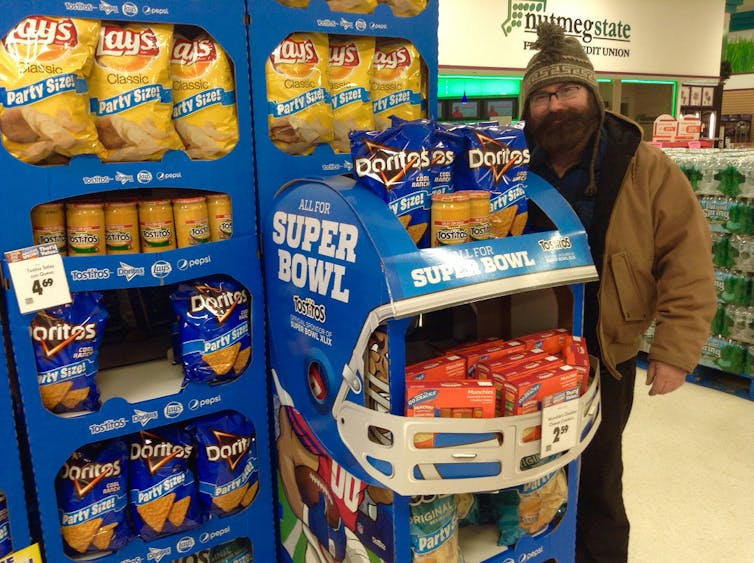Comeertials Thaqt the Same Thing Happerns Again and Again
In an era of increasing media fragmentation, you lot could draw the Super Bowl as the only annual media event where a substantial portion of the U.S. population gathers at the same time to watch the same thing: Over 100 million people tune in, and a good portion say the ads are the main reason they're watching in the first place.
For these reasons, the Super Bowl is the grandpa of all advertisement buys.
Just in recent years, the tradition of millions of people simultaneously sharing the same commercial experience has become more than complicated.
Every bit I discuss in my new book, advertisers are leveraging new technologies to track our personal habits and target u.s.a. with individualized advertising. In other words, they want to make sure the ads we see are aligned with our existing tastes and preferences. It's based on research showing that a "personalized" ad is more likely to stick in our heads and trigger a auction.
This sort of affair happens when we receive direct mail based on the type of car we own. It happens in the supermarket checkout lane when our shopper's loyalty menu tells advertisers our purchase histories.
It's happening during the Super Bowl, too. And information technology may even change the way we see Super Bowl ads in the future.
Companies build personal digital profiles
Journalists tend to make a sport out of Super Basin advertising. Like the stock marketplace, the prices of ads get analyzed. Like movie previews, teasers of ads for the big game are distributed and discussed before they air. And just like the game'south biggest plays, the ads go dissected afterward, with advertising experts breaking down which ones worked and which ones didn't.
Others recognize the collective nature of this consequence past characterizing Super Basin ads equally important reflections of the national spirit. Apple tree's famous "1984" ad channeled the Cold State of war. Other ads notoriously captured the dot-com bubble of the tardily 1990s. Terminal twelvemonth, diverse commercials were praised and critiqued for their implicit rebukes of the nascent Trump assistants.
But a Super Basin ad doesn't only end when its 30 seconds on Tv are upwards; information technology creeps into our lives in ways you might non realize.
By one guess, 78 percent of Super Bowl viewers will engage with social media while watching the game. When they do so, they will supply valuable data for hungry marketers. When private audition members share an ad or make a annotate about one on Facebook, Twitter or Instagram – either during the game or after – those posts are tracked and cataloged. They become part of our digital profiles, auctioned off to the highest advertisement applicant.
Those who are more interested in the political party or the game – but are nonetheless using social media – are still providing data that'due south valuable to advertisers.
Even an innocuous Super Basin party selfie tin be mined for advertising gold. For example, Coca-Cola recently used an paradigm recognition engine to identify people who posted pictures in which they appeared happy or excited with cans or bottles of their competitors. Coca-Cola then targeted these people with ads for their products on twoscore mobile sites and apps.
So if y'all're property a tin of Miller Light or a purse of Doritos, Budweiser and Pringles might accept note.

Mining our brains to tailor the ad experience
Perhaps the most startling grade of market enquiry going on is the commercial surveillance taking identify inside our heads.
Because there's so much money riding on each Super Bowl ad – more than than $5 one thousand thousand for each 30-second spot – advertisers want to make sure they resonate. It's difficult to mensurate advertising effectiveness, and so marketers have turned to brain science for an answer.
For over a decade, neuroscientists have been scanning the brains of select Super Bowl viewers to run across how they react to the commercials that air. Their studies purport to reveal the narratives and images that best capture the public'due south attention in a mode that postgame surveys of Super Bowl audiences cannot. This information can and then be leveraged to develop more constructive Super Bowl ads in the future.
Now, nonetheless, neuroscience is existence used in the service of advertisement customization. A test conducted during last year's Super Bowl scanned subjects' encephalon activity and tested their responses to different kinds of ads. Researchers adapted the social club of the ads shown during the game to fit each person's revealed preferences. (The exam required viewers to see the game on a 40-minute delay.)
Just every bit the neuroscientists had hoped, strategically altering the ordering of the ads to fit these preferences increased audience attention.
The ultimate goal of studies like this is to target viewers with personalized idiot box commercials. Cablevision providers and television networks are bullish on using new technologies to deliver something called "addressable television," the process of sending specific Idiot box commercials to individual households.
Personalized Tv has already been used to target married women with children with ads for an amusement park and international fliers with ads for online travel. But addressable television need non be limited to showcasing detail products. Commercials could exist customized to feature either a happy catastrophe or a sad ane, depending on who'south watching.
If television becomes notwithstanding another site of individual targeting – like social media and online browsing – something will be lost. The Super Basin, the outcome that seemingly brings the country together once a year, may become notwithstanding some other media experience that cloisters u.s. in our own digital bubbles.
Source: https://theconversation.com/the-transformation-of-the-super-bowl-ad-experience-91051
0 Response to "Comeertials Thaqt the Same Thing Happerns Again and Again"
Postar um comentário